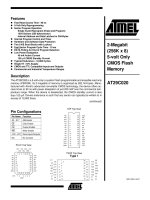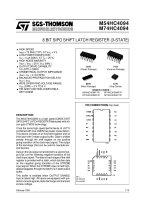Điện tử viễn thông LGW2EChapter5Presentation khotailieu
Bạn đang xem bản rút gọn của tài liệu. Xem và tải ngay bản đầy đủ của tài liệu tại đây (733.78 KB, 148 trang )
Chapter 5
Peer-to-Peer Protocols
and Data Link Layer
PART I: Peer-to-Peer Protocols
Peer-to-Peer Protocols and Service Models
ARQ Protocols and Reliable Data Transfer
Flow Control
Timing Recovery
TCP Reliable Stream Service & Flow Control
Chapter 5
Peer-to-Peer Protocols
and Data Link Layer
PART II: Data Link Controls
Framing
Point-to-Point Protocol
High-Level Data Link Control
Link Sharing Using Statistical Multiplexing
Chapter Overview
z
Peer-to-Peer protocols: many protocols involve the
interaction between two peers
z
z
z
z
Service Models are discussed & examples given
Detailed discussion of ARQ provides example of
development of peer-to-peer protocols
Flow control, TCP reliable stream, and timing recovery
Data Link Layer
z
z
z
Framing
PPP & HDLC protocols
Statistical multiplexing for link sharing
Chapter 5
Peer-to-Peer Protocols
and Data Link Layer
Peer-to-Peer Protocols and
Service Models
zzz
zzz
Peer-to-Peer Protocols
n + 1 peer process
SDU
PDU
z
Layer-(n+1) peer calls
layer-n and passes
Service Data Units
(SDUs) for transfer
z
Layer-n peers exchange
Protocol Data Units
(PDUs) to effect transfer
z
Layer-n delivers SDUs to
destination layer-(n+1)
peer
n peer process
n – 1 peer process
zzz
zzz
n – 1 peer process
Peer-to-Peer processes
execute layer-n protocol
to provide service to
layer-(n+1)
n + 1 peer process
SDU
n peer process
z
Service Models
z
z
The service model specifies the information transfer
service layer-n provides to layer-(n+1)
The most important distinction is whether the service
is:
z
z
z
Connection-oriented
Connectionless
Service model possible features:
z
z
z
z
z
Arbitrary message size or structure
Sequencing and Reliability
Timing, Pacing, and Flow control
Multiplexing
Privacy, integrity, and authentication
Connection-Oriented Transfer
Service
z
Connection Establishment
z
z
z
Message transfer phase
z
z
z
Connection must be established between layer-(n+1) peers
Layer-n protocol must: Set initial parameters, e.g. sequence
numbers; and Allocate resources, e.g. buffers
Exchange of SDUs
Disconnect phase
Example: TCP, PPP
n + 1 peer process
send
SDU
n + 1 peer process
receive
Layer n connection-oriented service
SDU
Connectionless Transfer Service
z
z
z
z
z
No Connection setup, simply send SDU
Each message send independently
Must provide all address information per message
Simple & quick
Example: UDP, IP
n + 1 peer process
send
SDU
n + 1 peer process
receive
Layer n connectionless service
Message Size and Structure
z
What message size and structure will a
service model accept?
z
z
z
z
Different services impose restrictions on size &
structure of data it will transfer
Single bit? Block of bytes? Byte stream?
Ex: Transfer of voice mail = 1 long message
Ex: Transfer of voice call = byte stream
1 voice mail= 1 message = entire sequence of speech samples
(a)
1 call = sequence of 1-byte messages
(b)
Segmentation & Blocking
z
z
z
To accommodate arbitrary message size, a layer may
have to deal with messages that are too long or too
short for its protocol
Segmentation & Reassembly: a layer breaks long
messages into smaller blocks and reassembles these
at the destination
Blocking & Unblocking: a layer combines small
messages into bigger blocks prior to transfer
1 long message
2 or more blocks
2 or more short messages
1 block
Reliability & Sequencing
z
z
z
z
Reliability: Are messages or information
stream delivered error-free and without loss
or duplication?
Sequencing: Are messages or information
stream delivered in order?
ARQ protocols combine error detection,
retransmission, and sequence numbering to
provide reliability & sequencing
Examples: TCP and HDLC
Pacing and Flow Control
z
z
z
z
Messages can be lost if receiving system
does not have sufficient buffering to store
arriving messages
If destination layer-(n+1) does not retrieve its
information fast enough, destination layer-n
buffers may overflow
Pacing & Flow Control provide backpressure
mechanisms that control transfer according to
availability of buffers at the destination
Examples: TCP and HDLC
Timing
z
z
z
z
z
Applications involving voice and video generate
units of information that are related temporally
Destination application must reconstruct temporal
relation in voice/video units
Network transfer introduces delay & jitter
Timing Recovery protocols use timestamps &
sequence numbering to control the delay & jitter in
delivered information
Examples: RTP & associated protocols in Voice
over IP
Multiplexing
z
z
z
Multiplexing enables multiple layer-(n+1)
users to share a layer-n service
A multiplexing tag is required to identify
specific users at the destination
Examples: UDP, IP
Privacy, Integrity, &
Authentication
z
z
z
z
z
Privacy: ensuring that information transferred
cannot be read by others
Integrity: ensuring that information is not
altered during transfer
Authentication: verifying that sender and/or
receiver are who they claim to be
Security protocols provide these services and
are discussed in Chapter 11
Examples: IPSec, SSL
End-to-End vs. Hop-by-Hop
z
A service feature can be provided by implementing a
protocol
z
z
z
Example:
z
z
z
end-to-end across the network
across every hop in the network
Perform error control at every hop in the network or only
between the source and destination?
Perform flow control between every hop in the network or
only between source & destination?
We next consider the tradeoffs between the two
approaches
Error control in Data Link Layer
Packets
Packets
Data link
layer
Data link
layer
(a)
A
2
3
B
Physical
layer
Physical
layer
(b)
12
Frames
z
1
21
2
Medium
12
3
B
2
1
A
1
Physical layer entity
2
Data link layer entity
3
Network layer entity
z
1
z
21
z
Data Link operates
over wire-like,
directly-connected
systems
Frames can be
corrupted or lost, but
arrive in order
Data link performs
error-checking &
retransmission
Ensures error-free
packet transfer
between two systems
Error Control in Transport Layer
z
z
Transport layer protocol (e.g. TCP) sends segments across
network and performs end-to-end error checking &
retransmission
Underlying network is assumed to be unreliable
Messages
Messages
Segments
Transport
layer
Transport
layer
Network
layer
Network
layer
Network
layer
Network
layer
Data link
layer
Data link
layer
Data link
layer
Data link
layer
layer
Physical
layer
Physical
layer
Physical
layer
End system
Physical
A
Network
End system
B
z
z
Segments can experience long delays, can be lost, or
arrive out-of-order because packets can follow different
paths across network
End-to-end error control protocol more difficult
1
End System
α
4 3 21
3
2
2 1
2
1
1
1
2 1
1 2
3
B
2
1
2
12
3
1 2
C
Medium
A
2
2
End System
β
1
2 1
1 2 3 4
Network
3
Network layer entity
4 Transport layer entity
End-to-End Approach Preferred
Hop-by-hop
Hop-by-hop
cannot ensure
E2E correctness
Data
1
Data
2
ACK/
NAK
Data
Data
3
4
ACK/
NAK
5
ACK/
NAK
Faster recovery
ACK/
NAK
Simple
inside the
network
End-to-end
ACK/NAK
1
2
Data
3
Data
5
4
Data
Data
More scalable
if complexity at
the edge
Chapter 5
Peer-to-Peer Protocols
and Data Link Layer
ARQ Protocols and Reliable
Data Transfer
Automatic Repeat Request (ARQ)
z
z
Purpose: to ensure a sequence of information
packets is delivered in order and without errors or
duplications despite transmission errors & losses
We will look at:
z
z
z
z
Stop-and-Wait ARQ
Go-Back N ARQ
Selective Repeat ARQ
Basic elements of ARQ:
z
z
z
z
Error-detecting code with high error coverage
ACKs (positive acknowledgments
NAKs (negative acknowlegments)
Timeout mechanism
Stop-and-Wait ARQ
Transmit a frame, wait for ACK
Error-free
packet
Packet
Information frame
Receiver
(Process B)
Transmitter
Timer set after (Process A)
each frame
transmission
Control frame
Header
Information
packet
Information frame
CRC
Header
CRC
Control frame: ACKs
Need for Sequence Numbers
(a) Frame 1 lost
A
B
Time-out
Time
Frame
0
Frame
1
ACK
(b) ACK lost
A
B
z
z
z
z
z
Frame
1
Frame
2
ACK
Time-out
Time
Frame
0
Frame
1
ACK
ACK
Frame
1
ACK
Frame
2
In cases (a) & (b) the transmitting station A acts the same way
But in case (b) the receiving station B accepts frame 1 twice
Question: How is the receiver to know the second frame is also frame 1?
Answer: Add frame sequence number in header
Slast is sequence number of most recent transmitted frame
Sequence Numbers
(c) Premature Time-out
Time-out
A
Time
Frame
0
ACK
B
z
z
z
z
z
z
Frame
0
ACK
Frame
1
Frame
2
The transmitting station A misinterprets duplicate ACKs
Incorrectly assumes second ACK acknowledges Frame 1
Question: How is the receiver to know second ACK is for frame 0?
Answer: Add frame sequence number in ACK header
Rnext is sequence number of next frame expected by the receiver
Implicitly acknowledges receipt of all prior frames









